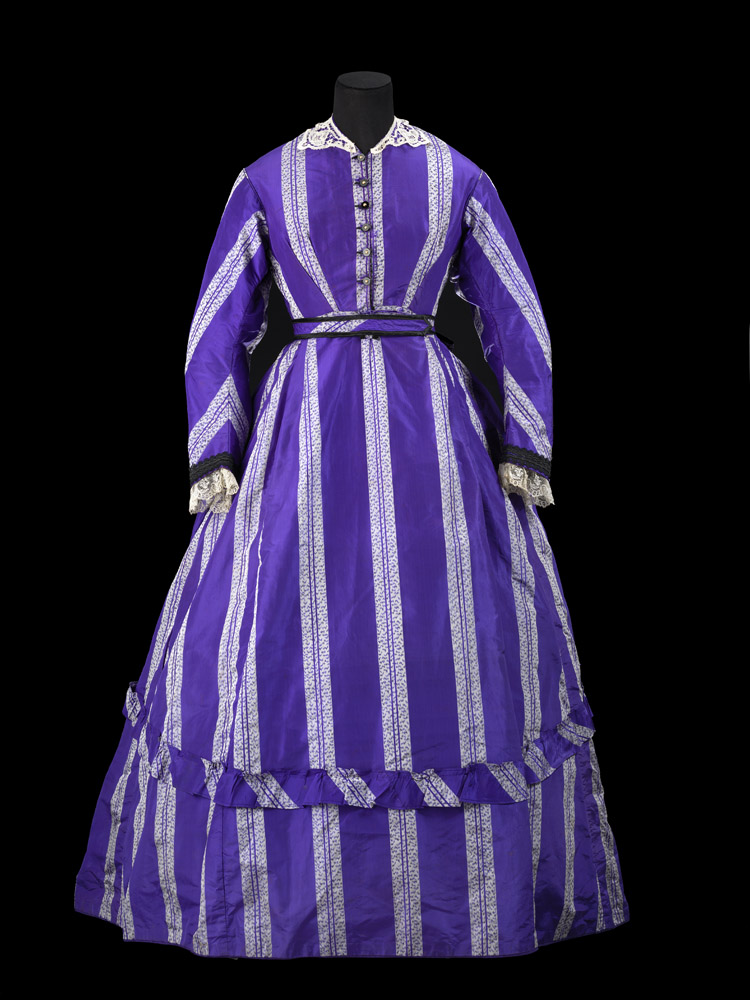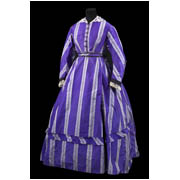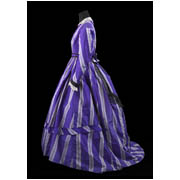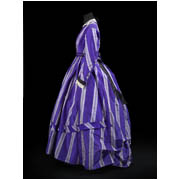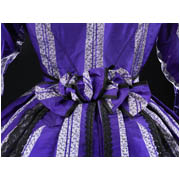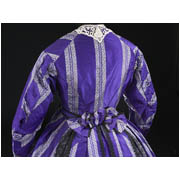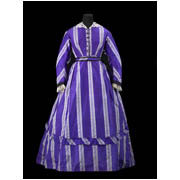Details
- Object type
dress
- Date
circa 1868
- Materials
silk, cotton, metal
- Dimensions
bust: 910 mm; footprint: 1000 mm x 1000 mm; waist: 660 mm
- Description
-
Woman’s dress (E.1982.2.6.a) and matching peplum (E.1982.2.6.b) in purple silk woven with broad stripes in a white mottled pattern. High neckline in v-shape, altered from round neckline, trimmed with white lace collar, centre front fastening with six black buttons with faux pearl centre. Full-length sleeves with band of decorative black corded ribbon at cuff, inside cuff with narrow white cotton lace ruffle. Skirt, full-length, flat at front, pleated into waistband at sides and back. Waistband fastening at wearer’s left front side with four metal hooks and four metal eyes. Watch pocket inside front waistband, large pocket on wearer’s right side seam. Lower skirt with one narrow frill of self-material, hem with purple wool braid. Inside lower skirt back with five closed metal hooks and metal rings, two pairs of cotton ties at each side of inside lower skirt to adjust rear hem of skirt. Bodice lined with drill cotton, sleeves lined with brown glazed cotton, skirt fully lined with glazed cotton with metal clips stamped 'NICOLLS' and rings to raise the hem. Peplum fastening at front with three metal hooks and eyes. Large bow centre back with four loops on one side, five on other side, two large tails edged with black corded ribbon, lower and outside edge of tails with black silk lace, gathered at lower edge. Waistband lined with black silk.
Walking dresses were popular in the 1860s. A contemporary commentator stated that 'At last it seems that Fashion has made a step in the direction of common sense; it is said that the new fashion is not likely to become popular for the reason that many women have not got pretty feet. Short skirts, for outdoor wear, are really a necessity, as evidenced by the devices (cords, strings, etc.) for holding up the dress.’ Whilst, some were made with slightly short skirts, this one has an example of one of these 'devices’ with pairs of small metal clips and rings sewn onto the lining of the lower skirt that can be fastened to raise the hem.
The dress is made from brightly-coloured aniline dyed purple silk with white striped. A matching belt with peplum panels reflects the growing emphasis on the back of the skirt that will later develop into the bustle. The neckline shows evidence of minor alterations as fashions changed with the original round neckline subsequently folded back to create a v-shaped opening.
Probably worn by either the donor's paternal grandmother, Margaret Hunter (1817-1901), the wife of Andrew Paterson, or her maternal grandmother, Mary Stevenson, wife of James Hamilton.
- Credit Line/Donor
Gifted, 1982
- ID Number
E.1982.2.6
- Location
In storage
